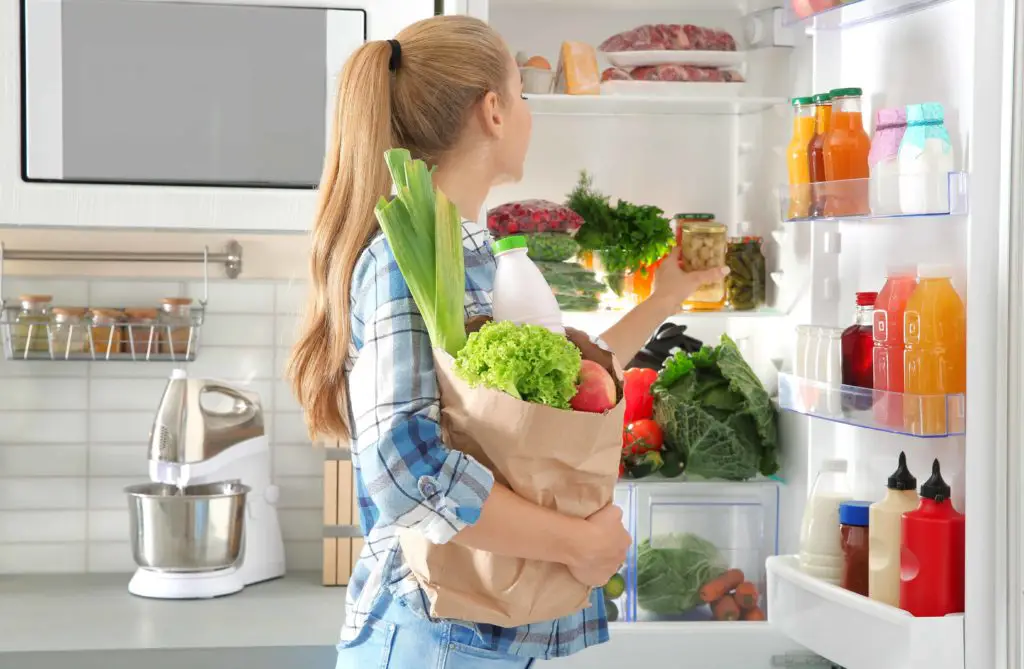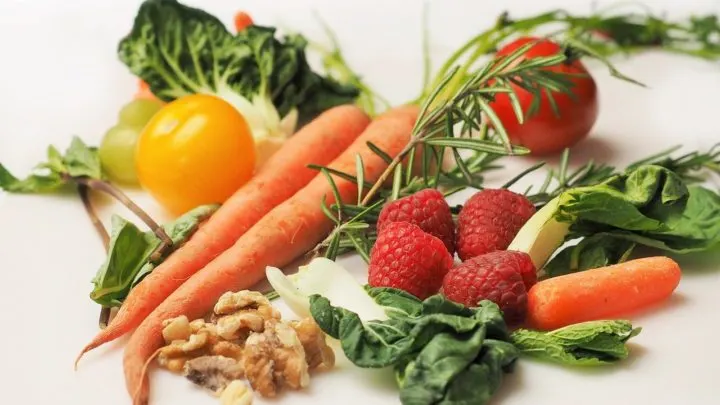How you are storing food affects how long it will last. If you’re frustrated by the amount of food you’ve wasted or you need to stretch your grocery budget, you need to read this!
How to Store Fresh Produce
Produce has a notoriously short shelf-life, but there are things you can do to make your fresh fruit and vegetables last longer.
Some produce belongs in the refrigerator.
These items should be stored in the refrigerator to maximize their shelf-life. However, there are specific ways to store them.
You need this in your fridge.
If you have an ethylene gas absorber in your fridge, your produce may last up to three times longer! This kit will work for an entire year.
Apples
Apples will last longer if they are stored in the refrigerator. This is because they continue to ripen after they are picked, and the cool air of the fridge slows the degradation process.
Apricots
Apricots will continue to ripen on the counter. Once they are fully ripe, put them in the fridge.
Artichokes
Artichokes should be kept in a bag or sealed container for maximum freshness.
Arugula
Arugula should be stored in a container with a damp towel.
Asparagus
Asparagus should be stored in the fridge. However, it should be treated like cut flowers. Stand them upright in a glass of water. Place a plastic bag over the top to protect it.
Avocado
Once an avocado is fully ripe, place it in the fridge. They should be stored loose.
Beans
Beans that are not dried or canned should be stored in a sealed container in the fridge.
Beets
Beets should be placed in a sealed container along with a dry paper towel. The leafy green tops should be removed and stored separately with other leafy greens.
Bell Peppers
Bell peppers belong in the crisper drawer of the fridge.
Berries
Fresh berries last longer if they are rinsed in a vinegar-water mix. Place one part vinegar in ten parts water. Swirl the berries in the mixture. Drain them, rinse them, and then dry them. Make sure they are thoroughly dry! The solution is weak enough that you won’t taste the vinegar, but you’ll notice that your berries last much longer.
Place a dry paper towel in the bottom of a shallow container. Cover the towel with the berries. Do NOT seal the container, though. Air circulation is important to keep berries fresh. If you store the container, they will mold much faster.
Bok Choy
Line a container with a damp towel. Place the bok choy on top of the towel, and store it sealed.
Broccoli and broccolini
Broccoli should be stored in the crisper drawer, wrapped in a damp towel.
Brussel Sprouts
Brussel sprouts should be stored in a sealed container in the crisper drawer.
Cabbage
Cabbage should be stored loose in the crisper drawer.
Cantaloupe
Cantaloupe should be stored in the fridge once it is fully ripe.
Carrots
Carrots must be stored in the fridge, in a sealed container with a dry paper towel. You will need to separate the green tops before storing them. The green tops can be stored with other leafy greens.
Cauliflower
To store cauliflower, place it in a plastic bag or sealed container. Keep in the crisper drawer.
Celery
Celery should always be stored in the fridge, inside a sealed container.
Chard
Chard should be wrapped in a damp paper towel and placed inside a sealed container. It must be kept in the fridge.
Cherries
Cherries should be stored in a plastic bag or sealed container. Do not wash them until you are ready to eat them.
Chives & Cilantro
Trim the stems of chives and cilantro before putting them upright in a glass of water. Cover with a plastic bag. Make sure you remove any bands, ties or other packaging before storing them this way.
Citrus
Citrus should be stored loose in the crisper drawer of the fridge.
Collard Greens
Collard greens should be stored in a sealed container that is lined with a damp towel. It must be kept in the fridge.
Corn
Store fresh corn loose in the fridge to maximize its longevity.
Cucumbers
Cucumbers will last the longest when they are stored loose in the fridge’s crisper drawer.
Grapes
Store grapes in a sealed container in the fridge. Do not wash them until you are ready to eat them.
Green Beans
Store green beans in a sealed container or plastic bag in the fridge.
Green Onions
Green onions will last longest when they are wrapped in a damp paper towel in the fridge.
Honeydew
Honeydew will ripen when left on the counter. When it is fully ripe, it should be stored loose in the refrigerator to extend its shelf-life. Once cut, it should be covered with plastic wrap.
Hot Peppers
Hot peppers should always be stored loose in a fridge crisper drawer.
Kale
To help your Kale last longer, store it in a sealed container lined with a damp towel. Put the container in the refrigerator.
Kiwi
Kiwi will ripen when left on the counter. When it is fully ripe, transfer it to the refrigerator and store it loosely to extend it’s shelf-life.
Leafy Greens
Leafy greens can be sealed in a container lined with a damp towel.
Leeks
Leeks should be stored in a crisper drawer, wrapped in a damp towel.
Lemons
Lemons should be stored loose in the refrigerator’s crisper drawer.
Lettuce
Lettuce should be stored in a sealed container, lined with a damp towel. Remove any bands, ties, or other packaging. Before you use, immerse the lettuce in ice water for 30 minutes.
Melons
Melons will ripen when left on the counter. Store them loose in the fridge once they are fully ripe. If you cut them, be sure to wrap the cut slices in plastic wrap before placing them back in the refrigerator.
Mint
Place mint in the fridge. Trim the stems and store it upright in a glass of water, with a plastic bag over the top. Be sure to remove any bands, ties, or other packaging!
Mushrooms
Mushrooms should be stored in the refrigerator, inside a paper bag.
Nectarines
Nectarines will ripen on the counter. Once fully ripe, they should be stored loose in the refrigerator.
Okra
Okra should be stored in a paper bag inside the refrigerator.
Oranges
Oranges will last longer if stored loosely in the refrigerator’s crisper drawer.
Oregano
Oregano should be stored in the refrigerator, wrapped in a damp towel and stored in a sealed container.
Parsley
Trim the stems and store upright in a glass of water. Place a plastic bag over the top.
Peaches
Peaches will ripen when left on the counter, so they should be placed in the refrigerator. Store them loose.
Pears
Pears should be stored like peaches.
Peppers
Peppers belong in the refrigerator’s crisper drawer. If you store partially-used peppers with their seeds and stems intact, they will last longer.
Pineapple
Pineapple should be left on the counter to ripen. Once ripe, it should be stored loose in the refrigerator.
Plums
Plums should be stored like pineapples.
Pomegranates
Pomegranates should be stored loose in the fridge.
Radicchio
Radicchio should always be stored in the fridge. Remove any bands, ties or other packaging. Wrap it in a damp towel and store it in a sealed container.
Radishes
In order to properly store radishes, you will need to separate the green tops from the remainder of the radish. Store the green tops according to the leafy greens instructions, above. Store the radishes in a sealed container with a dry paper towel.
Rhubarb
Rhubarb should be stored in the refrigerator, wrapped in a damp towel.
Rosemary
Rosemary should be stored in a sealed container with a damp towel.
Rutabagas
Rutabagas must be separated from their green tops. Store the tops according to the leafy greens section above. Place the rutabagas in a sealed container with a dry sealed towel.
Sage
Sage should be stored like rosemary.
Scallions
Scallions should be stored in a damp towel in the fridge.
Spinach
Spinach will last longest if it is stored in the fridge, inside a sealed container that is lined with a damp towel.
Sprouts
Sprouts should be stored in a sealed container in the refrigerator
Summer Squash
Summer Squash should be stored in the refrigetrator. Wrap any cut ends in a damp towel.
Tomatoes
Tomatoes should be stored in the refrigerator once they are fully ripe. Until they are ripe, store them on the counter out of direct sunlight.
Zucchini
Zucchini should be placed in the fridge. Wrap any cut ends with a damp towel.

Some produce belongs in the cupboard.
Most produce can be kept in a cupboard, as long as it is stored properly.
Acorn Squash
Acorn Squash should be stored loose, with plenty of air flow to decrease moisture.
Butternut Squash
Store butternut squash loose in the pantry.
Garlic
Fresh garlic can be stored loose in the cupboard or pantry.
Onions
Onions should be stored loose or in a mesh bag, inside a cupboard or pantry. If you put them in pantyhose and tie a knot between each onion, they can last for months!
Onions emit sulfur gas, which causes potatoes to spoil faster.
Potatoes
Potatoes should be stored loose or in a paper bag. Make sure to keep them away from the onions, or they will spoil much faster than they should!
Pumpkins
Store pumpkins loose in the cupboard or pantry.
Squash, Winter
Winter squash should be stored loosely in a cupboard or pantry. If you cut it, store it in the refrigerator inside a plastic bag or sealed container.
Some produce can be left on the counter.
Believe it or not, some produce will last longer if it is left on the counter.
Bananas
Bananas should be stored away from other fruits and vegetables. If you keep them separate, they will last longer.
Basil
Basil should be stored upright in a glass of water. Place a plastic bag over the top to protect it. Leave it on the counter, though.
Tomatoes
Tomatoes should be stored on the counter until they are fully ripe. To help them ripen faster, place them in a paper bag with an apple.
Watermelon
Watermelon should be left on the counter until fully ripe. After that, it can be stored in the refrigerator.

